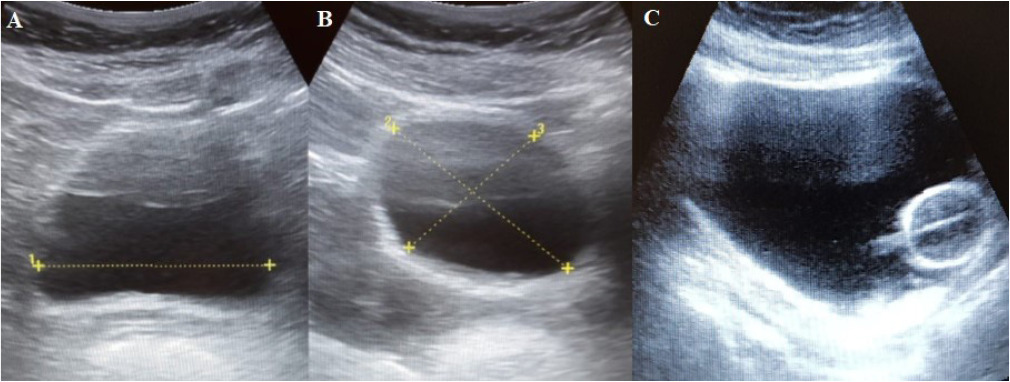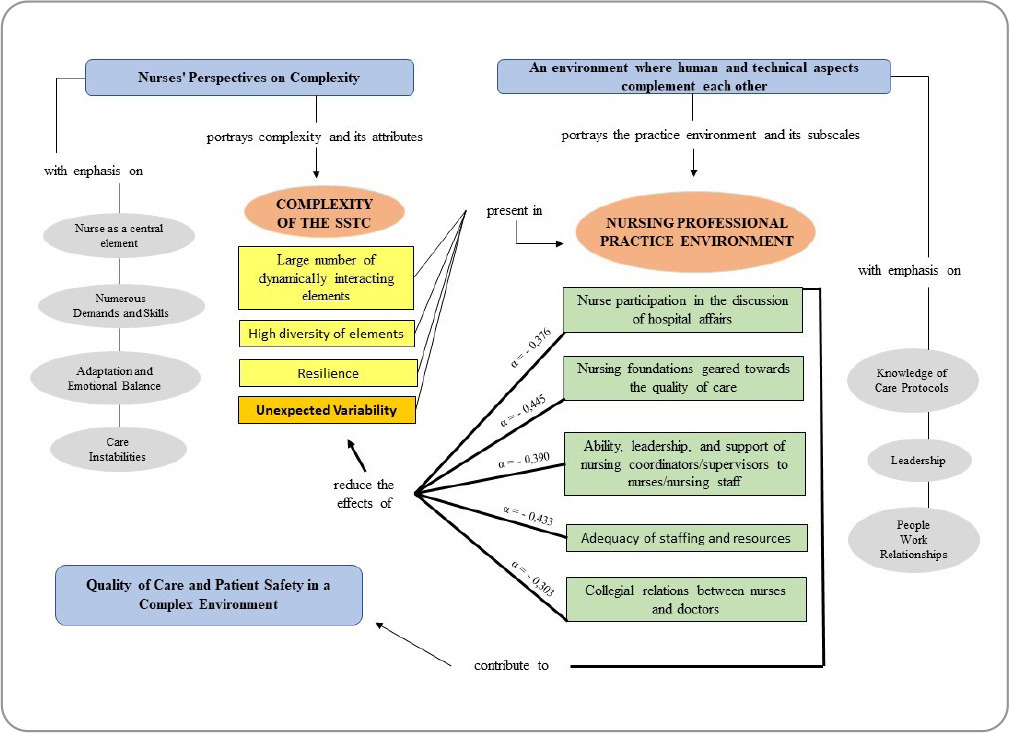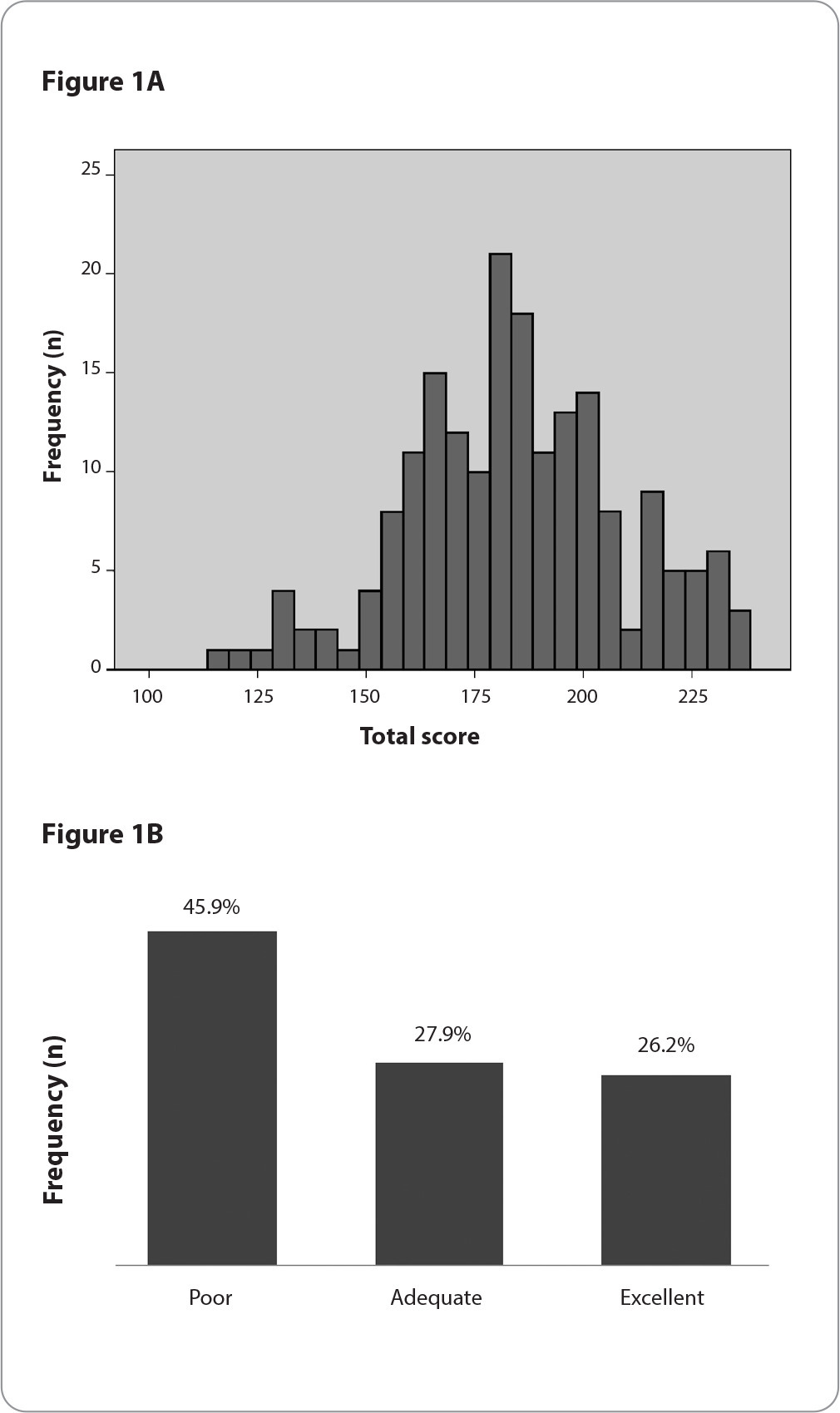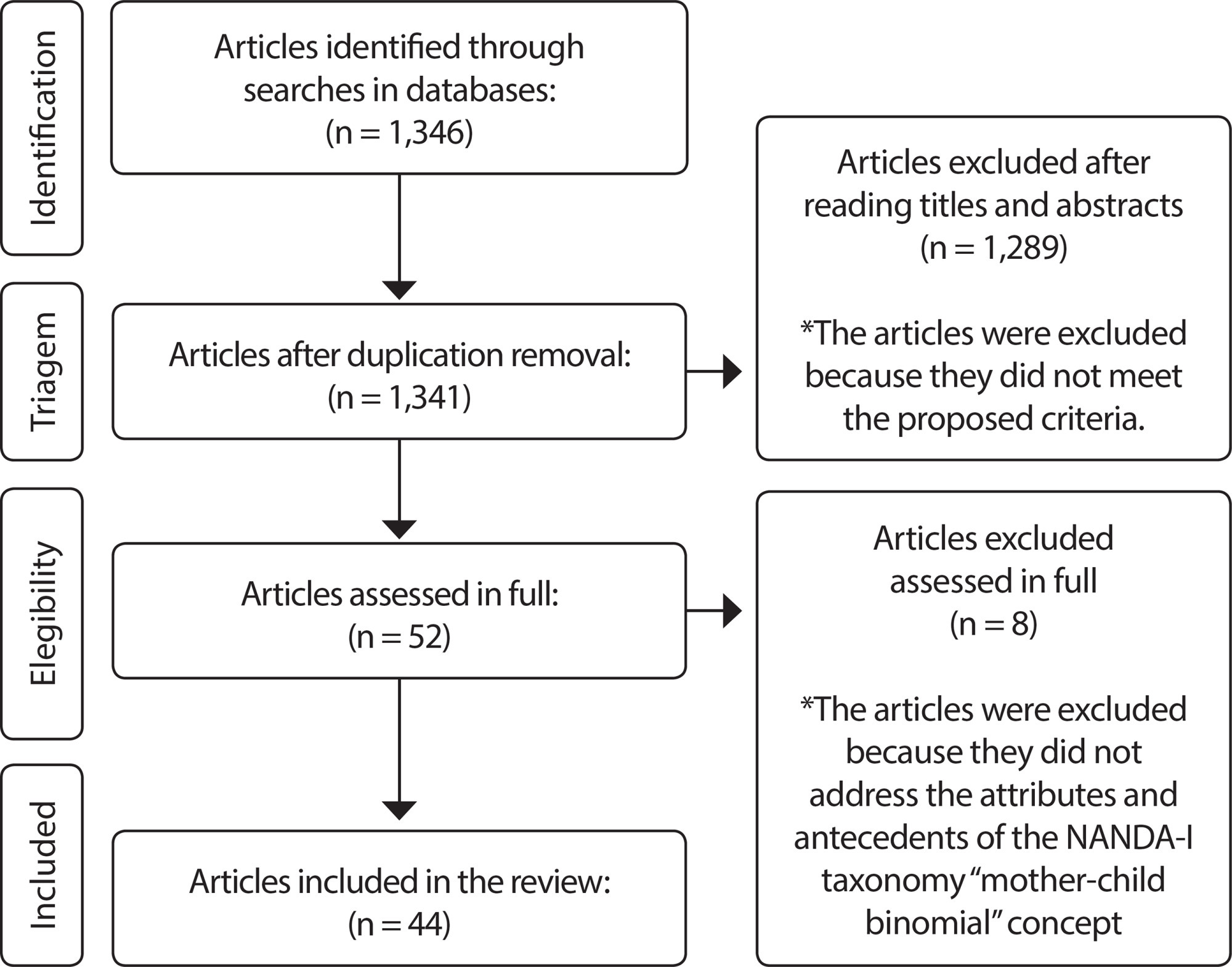-
ORIGINAL ARTICLE12-16-2024
Childbirth care by health professionals: conflicting practices in obstetrics
Revista Brasileira de Enfermagem. 2024;77(6):e20230129
Abstract
ORIGINAL ARTICLEChildbirth care by health professionals: conflicting practices in obstetrics
Revista Brasileira de Enfermagem. 2024;77(6):e20230129
DOI 10.1590/0034-7167-2023-0129
Views0See moreABSTRACT
Objectives:
to understand the perceptions of women and health professionals regarding childbirth care at a teaching hospital in the western state of Paraná, Brazil.
Methods:
this qualitative study employed Grounded Theory, conducted in an obstetric care service with 38 participants (women and health professionals) through semi-structured interviews.
Results:
limitations in physical infrastructure and management of care, along with the women’s limited knowledge about the childbirth process and the decision-making and guidance of professionals, show conflicting obstetric practices-a discrepancy between good practices and obstetric violence. Training in obstetric nursing and active participation in care, alongside the presence of a companion, were identified as intervening conditions and strategies in the process.
Final Considerations:
childbirth care is characterized by dichotomous practices. While some professionals base their practices on scientific evidence, others rely on teachings and experiences from the time of their training.
-
12-16-2024
Religión y experiencia profesional: ¿Serán predictores de la inteligencia espiritual de los enfermeros? Estudio transversal
Revista Brasileira de Enfermagem. 2024;77(6):e20240217
Abstract
Religión y experiencia profesional: ¿Serán predictores de la inteligencia espiritual de los enfermeros? Estudio transversal
Revista Brasileira de Enfermagem. 2024;77(6):e20240217
DOI 10.1590/0034-7167-2024-0217es
Views1See moreRESUMEN
Objetivos:
analizar la relación entre religión y experiencia profesional con la inteligencia espiritual en enfermeros.
Métodos:
estudio transversal y analítico realizado en 2021, participaron 544 profesionales de enfermería que laboraban en establecimiento de salud de Perú durante la pandemia por COVID-19. Para el análisis de los datos se emplearon el análisis de regresión múltiple y correlación de Pearson.
Resultados:
en los enfermeros predominó un nivel de inteligencia espiritual saludable (42,8%). Quienes no profesaban una religión tenían mayor probabilidad de tener menor puntaje de inteligencia espiritual (escala global y dimensiones); sin embargo, los enfermeros expertos tuvieron mayor probabilidad de tener mayor inteligencia espiritual (escala global y dimensiones) que los enfermeros novatos (p<0,05).
Conclusiones:
la inteligencia espiritual en los enfermeros fue predicha por la religión y la experiencia profesional. Este hallazgo sugiere que la inteligencia espiritual en enfermería se consolida mediante prácticas religiosas y durante el ejercicio profesional.
-
12-16-2024
A relação entre gênero, formação educacional e ambiente de aprendizagem com a ansiedade do estudante de enfermagem
Revista Brasileira de Enfermagem. 2024;77(6):e20220615
Abstract
A relação entre gênero, formação educacional e ambiente de aprendizagem com a ansiedade do estudante de enfermagem
Revista Brasileira de Enfermagem. 2024;77(6):e20220615
DOI 10.1590/0034-7167-2022-0615
Views1See moreRESUMEN
Objetivos:
identificar las variables asociadas a la práctica clínica relacionadas con la ansiedad de los estudiantes de enfermería.
Métodos:
se utilizó un diseño descriptivo, cuantitativo, correlacional con las recomendaciones STROBE, EQUATOR. La población fue de 233 estudiantes de enfermería con una muestra de 135 personas. Los datos se recopilaron de marzo a abril de 2022 utilizando instrumentos validados.
Resultados:
la prueba de chi-cuadrado y razón de verosimilitud significativa para género, formación académica y entorno de aprendizaje son superiores a 0.05, por lo que no existe una relación significativa entre las variables y la ansiedad de los estudiantes.
Conclusiones:
los estudiantes necesitan prepararse nuevamente antes de ingresar al campo de la práctica. Investigaciones cualitativas también son necesarias.
-
ORIGINAL ARTICLE12-16-2024
Bladder ultrasound: evidence of content validity of a checklist for training nurses
Revista Brasileira de Enfermagem. 2024;77(6):e20230183
Abstract
ORIGINAL ARTICLEBladder ultrasound: evidence of content validity of a checklist for training nurses
Revista Brasileira de Enfermagem. 2024;77(6):e20230183
DOI 10.1590/0034-7167-2023-0183
Views0See moreABSTRACT
Objectives:
to develop and analyze evidence of content validity of a checklist for training nurses in measuring bladder volume through ultrasound.
Methods:
a methodological study, consisting of three stages: literature review; instrument item preparation; and analysis of evidence of content validity. The Content Validity Index (CVI) and Gwet’s AC2 were used for content validity analyses.
Results:
the checklist consisted of 23 items. The CVIs for clarity, relevance and dimensionality were 0.99, 0.99 and 0.98 respectively, and the CVIs for Gwet’s AC2 with coefficients for clarity, relevance and dimensionality were 0.89, 0.97 and 0.95, respectively, with p<0.001.
Conclusions:
the checklist developed for training nurses in measuring bladder volume through ultrasound achieved adequate evidence of content validity, and can be used to train nurses in clinical practice and future research.

-
ORIGINAL ARTICLE12-16-2024
Nursing team’s perceptions about care for pregnant women in a psychiatric unit
Revista Brasileira de Enfermagem. 2024;77(6):e20230186
Abstract
ORIGINAL ARTICLENursing team’s perceptions about care for pregnant women in a psychiatric unit
Revista Brasileira de Enfermagem. 2024;77(6):e20230186
DOI 10.1590/0034-7167-2023-0186
Views0See moreABSTRACT
Objectives:
to understand the nursing team’s perception in relation to the care provided to pregnant women with mental disorders admitted to a psychiatric hospital unit.
Methods:
Convergent Care Research carried out between August and December 2021, through semi-structured interviews with 25 nursing professionals from a Psychiatric Unit from a reference Hospital in Southern Brazil.
Results:
the organized and analyzed data resulted in two thematic categories: Technical, generic and impersonal care; and From impersonality to the singularity of nursing care. Ensuring unique care for pregnant women with mental disorders means giving them a meaning of existence and providing care from a multidimensional and continuous perspective.
Final Considerations:
nursing care for pregnant women in psychiatric hospitalization requires continuous professional qualification, interactive technologies and support for the nursing process, in addition to promoting singular and multidimensional care.
-
ORIGINAL ARTICLE12-16-2024
The nursing practice environment and hospital sociotechnical complexity: a mixed-methods study
Revista Brasileira de Enfermagem. 2024;77(6):e20230315
Abstract
ORIGINAL ARTICLEThe nursing practice environment and hospital sociotechnical complexity: a mixed-methods study
Revista Brasileira de Enfermagem. 2024;77(6):e20230315
DOI 10.1590/0034-7167-2023-0315
Views1See moreABSTRACT
Objectives:
to analyze the relationship between the nursing practice environment and hospital sociotechnical complexity as perceived by nurses.
Methods:
a sequential explanatory mixed-methods study was conducted in a hospital in southern Brazil. The Brazilian version of the Practice Environment Scale-Nursing Work Index and the Complexity Characterization Questionnaire were administered to 132 nurses. Subsequently, semi-structured interviews were conducted with 18 participants, and the data were subjected to thematic analysis. Data integration was achieved through a connection approach.
Results:
the nursing practice environment was found to be favorable, except in the subscale concerning Staffing and Resource Adequacy, where complexity was present in the activities. The three emerging categories explained human and technical aspects related to complexity in the practice environment, quality of care, and patient safety. Unexpected variability was inversely correlated with the practice environment.
Conclusions:
the study results indicate a relationship between these constructs, with implications for the quality and the safety of care.

-
ORIGINAL ARTICLE12-16-2024
Factors associated with maternal well-being during childbirth among postpartum women in Minas Gerais
Revista Brasileira de Enfermagem. 2024;77(6):e20230304
Abstract
ORIGINAL ARTICLEFactors associated with maternal well-being during childbirth among postpartum women in Minas Gerais
Revista Brasileira de Enfermagem. 2024;77(6):e20230304
DOI 10.1590/0034-7167-2023-0304
Views0See moreABSTRACT
Objectives:
to analyze the factors associated with maternal well-being during childbirth among postpartum women in Minas Gerais.
Methods:
a cross-sectional study nested within a cohort was conducted with postpartum women in a municipality of Minas Gerais. The Maternal Well-being in Childbirth Scale 2 was used. The prevalence of maternal well-being during childbirth was estimated. The magnitude of the association between maternal distress and care practices was estimated using the Prevalence Ratio (PR), applying Poisson regression.
Results:
a total of 183 postpartum women aged between 15 and 46 years participated, with 26.2%, 27.9%, and 45.9% reporting excellent, adequate, and poor well-being during childbirth care, respectively. Maternal distress was more prevalent among women who underwent cesarean sections (PR = 1.60) and those who did not receive breastfeeding information (PR = 1.59).
Conclusions:
a high prevalence of maternal distress during childbirth was observed, associated with cesarean delivery and the lack of breastfeeding information.

-
ORIGINAL ARTICLE12-16-2024
Prevalence and factors associated with musculoskeletal pain among hospital cleaning staff
Revista Brasileira de Enfermagem. 2024;77(6):e20230237
Abstract
ORIGINAL ARTICLEPrevalence and factors associated with musculoskeletal pain among hospital cleaning staff
Revista Brasileira de Enfermagem. 2024;77(6):e20230237
DOI 10.1590/0034-7167-2023-0237
Views0See moreRESUMO
Objetivos:
verificar a prevalência e os fatores associados à dor musculoesquelética em trabalhadores do serviço hospitalar de limpeza.
Métodos:
estudo transversal, realizado com trabalhadores de limpeza de um hospital de ensino do Sul do Brasil. Utilizaram-se questionário com variáveis sociodemográficas, laborais e de saúde, o Nordic Musculoskeletal Questionnaire e o Diagrama de Corlett e Manenica. Realizou-se análise bivariada.
Resultados:
participaram 149 trabalhadores. Prevaleceu dor musculoesquelética na coluna lombar no último ano (65,8%) e últimos sete dias (42,3%). Constataram-se associações entre automedicação e dor na parte inferior das costas (p=0,020) e ombros (p=0,026); sedentarismo, oito horas de sono diárias e dor nos tornozelos (p=0,041) e pés (p=0,039); ex-tabagismo, uso de medicamento e dor nos punhos (p=0,015) e mãos (p=0,004).
Conclusões:
prevaleceram lombalgias associadas a hábitos de saúde e vida. Um programa de educação em saúde e recomendações de melhorias nos processos de trabalho podem minimizar a exposição à dor musculoesquelética.
-
REVIEW06-10-2022
Self-inflicted violence and suicide in people living with HIV/AIDS: a systematic review
Revista Brasileira de Enfermagem. 2022;75:e20210768
Abstract
REVIEWSelf-inflicted violence and suicide in people living with HIV/AIDS: a systematic review
Revista Brasileira de Enfermagem. 2022;75:e20210768
DOI 10.1590/0034-7167-2021-0768
Views0See moreABSTRACT
Objectives:
to analyze intellectual productions on self-inflicted violence and suicide in people living with HIV/AIDS.
Methods:
a systematic review, carried out between March and April 2021, in the PubMed®/MEDLINE®, Web of Science and LILACS databases, subsidized in the Strengthening the Reporting of Observational Studies in Epidemiology. The period outlined was from 2011 to 2020.
Results:
a total of 199 studies were identified, and 16 composed the final sample, grouped into the categories: Sociodemographic characteristics of victims of self-inflicted violence/suicide and their intervening factors (pointing to young adults, especially homosexuals, with low social support and a history of mental illness or substance abuse as usual victims); Successful measures for suicide prevention/control in people living with HIV/AIDS (suggesting more frequent psychosocial and clinical follow-up of those starting antiretroviral and immunocompromised treatment).
Conclusions:
biopsychosocial follow-up, analysis of sociodemographic profile and intervening factors should be frequent in this population for disease prevention/control.

-
ORIGINAL ARTICLE09-05-2022
Screening for common mental disorder in elderly residents in the countryside: a cross-sectional study
Revista Brasileira de Enfermagem. 2022;75:e20210875
Abstract
ORIGINAL ARTICLEScreening for common mental disorder in elderly residents in the countryside: a cross-sectional study
Revista Brasileira de Enfermagem. 2022;75:e20210875
DOI 10.1590/0034-7167-2021-0875
Views0See moreABSTRACT
Objective:
To estimate the prevalence of common mental disorders and their associated factors in the elderly in a municipality in the countryside of the Brazilian Midwest.
Methods:
Quantitative, observational, cross-sectional approach research, conducted with 218 elderly people.
Results:
The prevalence of the common mental disorder among the elderly was 25.1%; in the univariate analysis, it was higher in females (35.4%), in the age group of 80 years or older (46.1%), brown skin color (30.2%), widowed (42.6%), illiterate (47.6%), and retired (27.6%). In the multiple analysis, the variables female gender (p<0.006), age 80 years or older (p<0.036), dissatisfaction with life (p<0.009), lack of social interaction (p=0.017), and dysfunctional family (p=0.021) remained associated with CMD.
Conclusion:
The results revealed are helpful and contribute to the reinforcement of the need for mental health care in this population extract so growing worldwide.
-
ORIGINAL ARTICLE06-03-2022
Association between falls in older adults and prevention group
Revista Brasileira de Enfermagem. 2022;75:e20200207
Abstract
ORIGINAL ARTICLEAssociation between falls in older adults and prevention group
Revista Brasileira de Enfermagem. 2022;75:e20200207
DOI 10.1590/0034-7167-2020-0207
Views0See moreABSTRACT
Objectives:
to assess the effectiveness of guidelines on fall prevention in a group of older adults in Primary Health Care.
Methods:
a cross-sectional study, carried out with older adults selected by a simple random sample (274; N=1,234). Data covered sociodemographic and socioeconomic variables, marital status, health conditions, factors associated with falls and participation in the prevention group. Student’s t test was used, and dichotomous variables were used by the chi-square test. The project met ethical requirements.
Results:
sample with female profile (61.7%), married, with low education, mean age of 71.69 years. The factors associated with falls identified were female sex, medicalization and participation in the prevention group. There was no protective association between participation in a fall prevention group in older adults and a decrease in the number of falls.
Conclusions:
based on evidence, a personalized intervention during the nursing visit is suggested as a strategy to prevent falls.

-
ORIGINAL ARTICLE03-07-2022
Predictors of frailty in older people users of Primary Health Care
Revista Brasileira de Enfermagem. 2022;75:e20201292
Abstract
ORIGINAL ARTICLEPredictors of frailty in older people users of Primary Health Care
Revista Brasileira de Enfermagem. 2022;75:e20201292
DOI 10.1590/0034-7167-2020-1292
Views0See moreABSTRACT
Objective:
to identify the prevalence and predictors of frailty in older people in Primary Health Care.
Method:
this is a descriptive and correlational study, carried out in a convenience sample of 136 older people in the community. Data were collected through a sociodemographic and clinical questionnaire and frailty phenotype. Student’s t test or U-Mann-Whitney test, chi-square and binary logistic regression were used for data analysis.
Results:
the prevalence of frailty was 26.5% (n=36). Frail individuals had older age (p=0.011), worse self-rated health (p=0.001) and lower physical capacity (p<0.001). In the multivariable regression, it was observed that frail individuals had older age (Odds Ratio=1.111; 95% confidence interval=1.026-1.203) and worse physical capacity (Odds Ratio=0.673; 95% confidence interval=0.508-0.893).
Conclusions:
the prevalence of frailty in older people in Primary Health Care was considerable. Advanced age and worse physical capacity were the most relevant predictors of frailty in the elderly.
-
ORIGINAL ARTICLE04-15-2022
Validation of Questionnaire to Assess the Impact of Dementia on the Family
Revista Brasileira de Enfermagem. 2022;75:e20210232
Abstract
ORIGINAL ARTICLEValidation of Questionnaire to Assess the Impact of Dementia on the Family
Revista Brasileira de Enfermagem. 2022;75:e20210232
DOI 10.1590/0034-7167-2021-0232
Views0See moreABSTRACT
Objective:
To validate a questionnaire to assess the impact of dementia on one of the household members.
Methods:
Methodological study. The instrument was designed based on literature review, expert opinion, and researchers’ experience and then applied to a non-probability convenience sample consisting of 262 family members who live daily with a person with dementia. The construct validity was studied by exploratory factor analysis, principal components method, with varimax rotation of the items.
Results:
An instrument with 30 items was obtained, distributed in four dimensions: “Emotional dimension,” “Economic dimension,” “Family relations dimension,” and “Support-seeking dimension.” Factor analysis revealed a total explained variance of 54.96% and a total Cronbach’s alpha of .899.
Conclusions:
The instrument presents high internal consistency, grouped into four dimensions, all closely related to the family’s adaptation to the onset of dementia in one of its members.
-
ORIGINAL ARTICLE03-07-2022
Is self-esteem associated with the elderly person’s quality of life?
Revista Brasileira de Enfermagem. 2022;75:e20210388
Abstract
ORIGINAL ARTICLEIs self-esteem associated with the elderly person’s quality of life?
Revista Brasileira de Enfermagem. 2022;75:e20210388
DOI 10.1590/0034-7167-2021-0388
Views0See moreABSTRACT
Objective:
To analyze the association between self-esteem and quality of life in the elderly.
Methods:
Cross-sectional web survey developed with 519 elderly people. Participants filled out three data collection instruments developed on the Google Forms platform and widely disseminated through all of Brazil. Fisher’s exact test, Mann-Whitney, Pearson correlation, and linear regression with 95% confidence interval were used.
Results:
Self-esteem was associated with all quality-of-life facets: sensory skills [β= 1.307; p<0.001]; autonomy [β= 2.101; p<0.001]; past, present, and future activities [β= 2.486; p<0.001]; social presence [β= 2.547; p<0.001]; death and dying [β= 2.175; p<0.001]; and intimacy [β=2.378; p<0.001].
Conclusion:
There is a positive and statistically significant association between self-esteem and quality of life in the elderly. We therefore suggest the development of local policies capable of raising this age groups’ self-esteem and reaffirming aging as a new possibility for discoveries and pleasure.
-
EXPERIENCE REPORT10-24-2022
Nursing process for elderly women susceptible to falls from the perspective of the Pender’s Model
Revista Brasileira de Enfermagem. 2022;75:e20210913
Abstract
EXPERIENCE REPORTNursing process for elderly women susceptible to falls from the perspective of the Pender’s Model
Revista Brasileira de Enfermagem. 2022;75:e20210913
DOI 10.1590/0034-7167-2021-0913
Views0See moreABSTRACT
Objectives:
to describe the strategy of applying the nursing process guided by Pender’s Health Promotion Model to elderly women susceptible to falls with a view to promoting a self-efficacy behavior for fall prevention.
Methods:
application of the nursing process to eleven elderly women who had already experienced falls, living in a neighborhood in the outskirts of Belem, state of Pará, which involved interviews to obtain their nursing history and group meetings using the focus group technique to develop the other phases of the nursing process: nursing diagnosis, nursing interventions, and nursing assessment.
Results:
despite the risk factors for falls, the intervention model adopted in this study allowed elderly women to enhance their self-efficacy.
Final Considerations:
the model proved to be suitable for the participation of elderly women in actions to build fall prevention behaviors, with a view to healthier lifestyles.

-
ORIGINAL ARTICLE10-24-2022
Factors associated with symptoms of physical and emotional burden in informal caregivers of the elderly
Revista Brasileira de Enfermagem. 2022;75:e20210927
Abstract
ORIGINAL ARTICLEFactors associated with symptoms of physical and emotional burden in informal caregivers of the elderly
Revista Brasileira de Enfermagem. 2022;75:e20210927
DOI 10.1590/0034-7167-2021-0927
Views1See moreABSTRACT
Objectives:
to analyze the personal and work-related burden factors associated with physical and emotional symptoms of informal caregivers of the elderly.
Methods:
cross-sectional study conducted with 121 informal caregivers and 121 seniors who received care, assessed individually for the risk of: physical overload, musculoskeletal symptoms, Self-Reporting Questionnaire, effort perception, and Katz index.
Results:
a greater perception of effort raises up to 3.3 times the chances of presenting symptoms of pain in the spine region (p=0.01), and lower functional capacity of the elderly increases up to 1.3 times the chances of presenting pain symptoms in the spine region (p=0.02). The symptoms of emotional overload were associated with the caregiver’s low income (p=0.02).
Conclusions:
the perception of effort, dependence of the elderly, caregiver’s age, and symptoms of emotional overload are involved with caregivers’ symptoms of physical overload, and low income, with emotional overload.
-
ORIGINAL ARTICLE11-02-2020
Elderly residents in the community: gaining knowledge to support a rehabilitation nursing program
Revista Brasileira de Enfermagem. 2020;73:e20200194
Abstract
ORIGINAL ARTICLEElderly residents in the community: gaining knowledge to support a rehabilitation nursing program
Revista Brasileira de Enfermagem. 2020;73:e20200194
DOI 10.1590/0034-7167-2020-0194
Views0See moreABSTRACT
Objective:
To analyze the socio-demographic and health conditions of the elderly living in the community and describe the pillars for the design of a rehabilitation nursing program in the community.
Methods:
Descriptive, cross-sectional study, with participation of 48 elderly selected by convenience sampling. Data collection took place between September 2018 and July 2019, in a health unit in northern Portugal, using a form.
Results:
All the elderly have pathological processes and overweight. Most of them are sedentary, have feelings of loneliness and inappropriate relational behaviors. In the last six months, 25% have fallen at least once, with notable changes in balance, lifestyles and perceived health status.
Conclusion:
The need for rehabilitation nurses to design and implement active aging programs that ensure individual accompaniment of the elderly by valuing lifestyles, balance training and promotion of social participation was highlighted.

-
ORIGINAL ARTICLE11-02-2020
Association of the functional capacity and violence in the elderly community
Revista Brasileira de Enfermagem. 2020;73:e20200209
Abstract
ORIGINAL ARTICLEAssociation of the functional capacity and violence in the elderly community
Revista Brasileira de Enfermagem. 2020;73:e20200209
DOI 10.1590/0034-7167-2020-0209
Views0See moreABSTRACT
Objective:
To analyze the relationship between the functional capacity of elderly community members and the sociodemographic and violence characteristics.
Methods:
Cross-sectional, epidemiological, analytical study with 159 elderly people. For data collection, a questionnaire was used for sociodemographic characterization; the Katz, Lawton and Brody scale; a questionnaire adapted from the FIBRA network; and the Conflict Tactics Scales, analyzed using descriptive and inferential statistics using Pearson’s chi-square test, Fisher’s exact test and multiple logistic regression models.
Results:
It was observed that the sociodemographic variables influence the prevalence of functional dependence for basic activities of daily living and reduction in advanced activities in elderly people with psychological and physical violence.
Conclusion:
The dependence of the elderly for basic and intermediate activities is related to characteristics such as advanced age, work exercise and knowing how to read and write. The participants’ functional dependence can favor violent outcomes, whether physical or psychological.
-
ORIGINAL ARTICLE02-10-2020
Repercussions of family violence: oral history of adolescents
Revista Brasileira de Enfermagem. 2020;73(1):e20180228
Abstract
ORIGINAL ARTICLERepercussions of family violence: oral history of adolescents
Revista Brasileira de Enfermagem. 2020;73(1):e20180228
DOI 10.1590/0034-7167-2018-0228
Views0See moreABSTRACT
Objective:
To know the repercussions of the experience of family violence from the oral history of adolescents.
Method:
Qualitative study based on the Oral History method, conducted from interviews with adolescents enrolled in a public school in Salvador, State of Bahia, Brazil. The data were systematized according to the thematic analysis and supported by theoretical references on family violence and adolescence.
Results:
Family violence implies physical illness associated with the damage caused by physical aggression and somatization of violent events, as well as compromising mental health, provoking feelings of deep sadness, self-injury behavior and suicidal ideation. All of these factors impair interpersonal relationships, school performance, as well as making them more vulnerable to alcohol intake.
Final Considerations:
The study indicates signs suggestive of grievance, from which the professionals should proceed the investigation in order to refute or confirm the experience of the phenomenon, as well as intervene in the cases.

-
ORIGINAL ARTICLE08-19-2019
Terms of specialized nursing language for people with pressure injury
Revista Brasileira de Enfermagem. 2019;72(4):1028-1035
Abstract
ORIGINAL ARTICLETerms of specialized nursing language for people with pressure injury
Revista Brasileira de Enfermagem. 2019;72(4):1028-1035
DOI 10.1590/0034-7167-2018-0492
Views0See moreABSTRACT
Objective:
to validate the terms of the specialized nursing language used in care for hospitalized patients with Pressure Injury, identified in nurses’ records, mapping them with the terms of the International Classification for Nursing Practice (ICNP® 2017).
Methods:
methodological study, carried out at a School Hospital in 2018. It was performed: extraction of terms of medical records; normalization; cross-mapping between extracted terms and those in ICNP®; distribution in the seven axes; theoretical definition and validation of terms.
Results:
27,756 terms were extracted. The normalization resulted in 370 relevant terms, being: 225 listed and 145 not listed in the ICNP®, being 60 similar, 13 more comprehensive, 38 more restricted and 34 without agreement, all of which are validated.
Conclusion:
this study identified and validated terms used by nurses to assist people with Pressure Injury. These may contribute to the unification of professional nursing language in care for these clients.
-
ORIGINAL ARTICLE07-13-2020
Faith and spirituality in the meaning of life of the elderly with Chronic Kidney Disease
Revista Brasileira de Enfermagem. 2020;73:e20190323
Abstract
ORIGINAL ARTICLEFaith and spirituality in the meaning of life of the elderly with Chronic Kidney Disease
Revista Brasileira de Enfermagem. 2020;73:e20190323
DOI 10.1590/0034-7167-2019-0323
Views0See moreABSTRACT
Objective:
to understand faith and spirituality in the meaning of life of the elderly with Chronic Kidney Disease.
Methods:
a qualitative research based on Viktor Emil Frankl’s Logotherapy and Existential Analysis. Twenty elderly people were interviewed between August 2018 and January 2019, between 60 and 79 years old, who underwent dialysis in a private unit, a reference in nephrology in the city of Salvador, Bahia, Brazil.
Results:
two categories of analysis emerged: Meaning of faith in the lived of the elderly with Chronic Kidney Disease; Faith as a forerunner of the meaning of life.
Final considerations:
faith and spirituality were understood as a fundamental foundation in the search for the meaning of the study participants’ lives, besides unveiling itself as an important strategy of resilience to the experienced of the elderly person with Chronic Kidney Disease.
-
ORIGINAL ARTICLE08-07-2020
Factors associated with depressive symptoms and cognition in elderly victims of violence
Revista Brasileira de Enfermagem. 2020;73:e20190383
Abstract
ORIGINAL ARTICLEFactors associated with depressive symptoms and cognition in elderly victims of violence
Revista Brasileira de Enfermagem. 2020;73:e20190383
DOI 10.1590/0034-7167-2019-0383
Views0See moreABSTRACT
Objective:
To identify, among elderly people victims of violence, factors associated with depressive symptoms and cognitive function.
Method:
This was a cross-sectional study carried out with 56 elderly people classified in situation of violence. To do so it was used the Brazil Old Age Shedule (BOAS), the Conflict Tactics Scales Form R, the Geriatric Depression Scale (GDS) and the Mini-mental State examination (MMSE).
Results:
Depressive symptoms were more predominant in elderly men, over 70 years old, without partner, illiterate, with no job, receiving up to 1 minimum wage and who lived alone; and the cognitive deficit prevailed in women, over 70 years old, without partner, illiterate, who did not work, receiving up to 1 minimum wage and who lived alone.
Conclusion:
Among the elderly population victim of violence, lack of a partner and cognitive impairment were associated to depressive symptoms; and finding themselves living alone, with no partner and being illiterate were associated to cognitive deficit.
-
REVIEW09-21-2020
Analysis of the NANDA-I taxonomy “maternal-fetal dyad” concept in high-risk pregnancy: integrative review
Revista Brasileira de Enfermagem. 2020;73:e20190649
Abstract
REVIEWAnalysis of the NANDA-I taxonomy “maternal-fetal dyad” concept in high-risk pregnancy: integrative review
Revista Brasileira de Enfermagem. 2020;73:e20190649
DOI 10.1590/0034-7167-2019-0649
Views1See moreABSTRACT
Objective:
to analyze the NANDA-I taxonomy “maternal-fetal dyad” concept in high-risk pregnancy.
Method:
an integrative literature review based on the Conceptual Analysis model proposed by Walker and Avant. It was conducted at PUBMED, CINAHL, SCOPUS, LILACS and SciELO, with the descriptors: Complications of pregnancy, Risk Factors, and Pregnancy, High-Risk (from 2008-2020).
Result:
the sample consisted of 44 articles, which identified two attributes and 21 antecedents of the concept.
Conclusion:
concept analysis allowed to identify the attributes and antecedents of the “maternal-fetal dyad” concept in high-risk pregnancy, in addition to raising and clarifying ideas. It was possible to identify 12 antecedents that are not included in NANDA-I as well as the need to review the definition of the diagnosis proposed by the taxonomy.

-
REVIEW11-06-2020
Suicide in the elderly: approach to social determinants of health in the Dahlgren and Whitehead model
Revista Brasileira de Enfermagem. 2020;73:e20200332
Abstract
REVIEWSuicide in the elderly: approach to social determinants of health in the Dahlgren and Whitehead model
Revista Brasileira de Enfermagem. 2020;73:e20200332
DOI 10.1590/0034-7167-2020-0332
Views0See moreABSTRACT
Objective:
Identify in literature the social determinants of health related to suicide in the elderly, according to the model proposed by Dahlgren and Whitehead.
Method:
Integrative review of articles indexed in the databases BDENF, CINAHL, LILACS, and MEDLINE, with the following main descriptors: aged, suicide, social determinants of health, and risk factors. Primary studies were included which addressed social determinants of health and suicide in the elderly.
Results:
From the 19 articles analyzed, three categories emerged: proximal social determinants of health (male gender, mental disorders, physical illnesses, white race, 70-74 years old); intermediate social determinants of health (substance abuse, use of alcohol or psychotropic drugs, marital status, marital, social, and family problems, violence, previous suicide attempt, history of admission to psychiatric service); and distal social determinants of health (schooling, economic issues, sanitation, stressful events).
Conclusion:
Proximal determinants have more effects on suicide. Intermediate determinants are composed mainly of changeable factors. Distal determinants showed lesser associations.

Search
Search in:
Nuvem de Tags
Adolescente (85) Atenção Primária à Saúde (239) COVID-19 (91) Criança (91) Cuidados de Enfermagem (269) Educação em Enfermagem (151) Educação em Saúde (139) Enfermagem (930) Enfermagem Pediátrica (86) Estudantes de Enfermagem (77) Estudos de Validação (131) Família (87) Idoso (208) Promoção da Saúde (99) Qualidade de Vida (104) Saúde do Trabalhador (86) Saúde Mental (145) Saúde Pública (82) Segurança do Paciente (150) Tecnologia Educacional (100)



